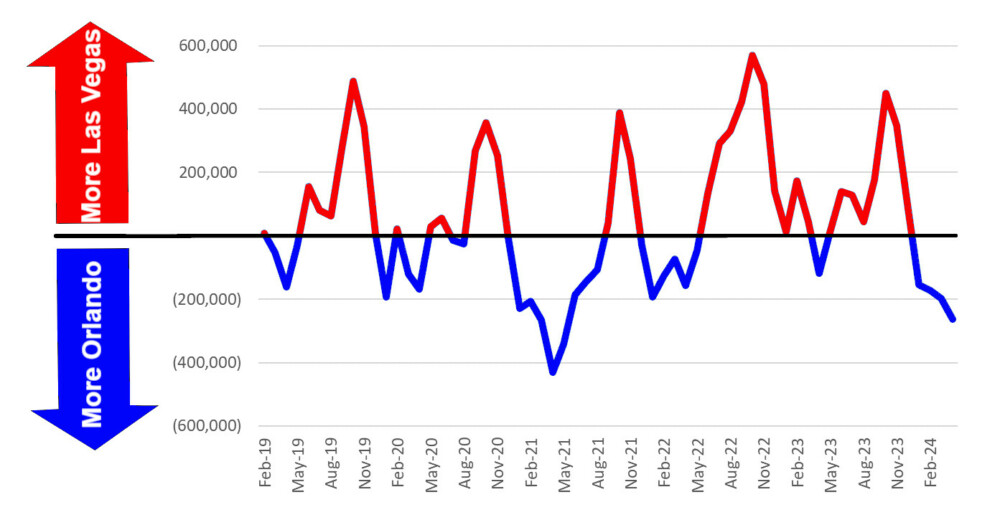We heard last year all about the struggles in the ultra low cost carrier (ULCC) world, but now that we have DOT’s Q3 2023 data, we can see just how bad things were. I was particularly interested to look at Orlando data, since that city has always seemed to be the bottomless pit of demand. Apparently… it has a bottom, because Q3 was downright ugly.
Let’s start with a look at how the biggest players in Orlando did year-over-year from a systemwide perspective so we can set a baseline.
Q3 2023 vs Q3 2022 by Airline
In this chart, we have average fare, seats, and passengers. What obviously stands out is Frontier which had the highest percentage increase in seats along with the biggest average drop in fare. Even worse, passenger numbers weren’t up nearly as much as seats, so loads suffered. It was a disastrous result for the airline across the board.
United actually grew the next largest amount, but its passenger growth exceeded seats. It also saw fares drop much less than Frontier. And then there’s Spirit which saw less growth but its fares dropped far more significantly.
What can we make of this? Overall, the ULCCs really took the brunt of the pain. Even Allegiant — an airline which actually shrunk capacity — had its fares drop similarly to what United saw on big capacity growth. The bottom end of the market just dropped out completely while the top end held up.
If we look at all airlines in the domestic market, passenger numbers were up 7 percent in Q3 2023 vs Q3 2022, but the fare dropped 6 percent. That gives you a sense of the systemwide trend.
Then there’s Orlando. And to make sure we’re all on the same page, I included both Orlando International (MCO) and Sanford (SFB) where Allegiant flies in all the data.
In Orlando, passenger growth outpaced the system with an increase of 9 percent. But the average fare plunged 16 percent. And when we break it down, fortunes varied greatly as we saw on a systemwide level.
Orlando Local Performance Q3 2023 vs Q3 2022
The three main ULCCs — Frontier, Spirit, and Allegiant — all saw a notable increase in passengers, up 12 percent combined vs last year. But look at how the fare fell off a cliff, down 28 percent. It’s hard to understand just how bad things were.
Frontier saw its fares dive the most — and well worse than system — off 33.3 percent. Let’s put this another way. Frontier flew nearly 16 percent more seats in Orlando in Q3 2023 vs the previous year, but it actually had 27 percent less in total revenue. Of course, this excludes ancillary revenue, but there’s no way that ancillary revenue made up for that kind of drop-off.
I don’t want to suggest that this is entirely a ULCC issue. It isn’t. All airlines saw fares drop more than the system average, as you can see in the chart. But nothing dropped even close to what happened with the ULCCs.
So what happened?
In short, a ton of capacity was added into the Orlando market, because time and time again that market showed it could absorb it. This time, it couldn’t. There weren’t enough people willing to go to and from Orlando to fill all those extra seats.
The legacy carriers, Southwest, and JetBlue were able to lower fares a little and give up some load factor to varying degrees in order to prevent fares from falling through the floor. Delta’s loads actually stayed flat, but JetBlue’s load factor was off 2.2 points vs last year, United’s dropped 3.4 points, Southwest dropped 5.75 points and American tanked by going down nearly 7 points.
But the ULCCs make so much money on ancillaries that they felt the need to really lower fares dramatically in order to get more people onboard no matter the price of admission. In this case, it didn’t work. Despite the massive cut in fares, Frontier and Allegiant both saw their loads drop by 2.3 points. Spirit fared slightly better at around 1.5 points down. Just imagine how bad it would have been had they not dropped fares.
The takeaway here is that there was way too much capacity in that market, and lessons will be learned. Orlando has finally hit a wall, and we imagine it will be a race to see who can cut the most there in order to improve overall performance.
Discover more from reviewer4you.com
Subscribe to get the latest posts to your email.



